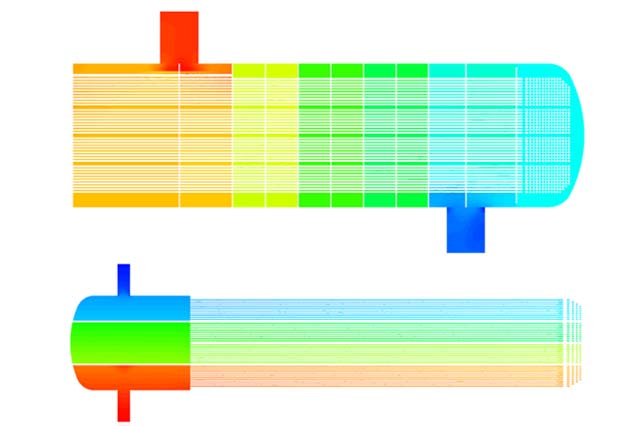The CFD Analysis of Shell and Tube Heat Exchanger is important in industries. It helps transfer heat between a cold fluid and a hot gas efficiently.
In this detailed case study, we examine a CFD Analysis of Shell and Tube Heat Exchanger. We analyze over 1300 tubes using Computational Fluid Dynamics (CFD). The main goal is to study heat movement in different fluid phases in the exchanger. We do this to ensure optimal performance and prevent ice formation in specific cold areas.
We conduct the CFD analysis on the complicated geometry of the CFD Analysis of Shell and Tube Heat Exchanger. The cold fluid stream, comprising a multiphase fluid, enters the heat exchanger tubes from the top. This study examines more than 1300 tubes in the CFD field, revealing the intricate heat and fluid movements in the system. The aim is to assess pressure, temperature, and velocity distribution along the length of the heat exchanger tubes.
Multiphase Flow Dynamics:
CFD analysis is necessary to understand the complex fluid dynamics in heat exchange with multiphase fluids. We carefully study how heat moves between the cold fluid and hot gas in the tubes to make it more efficient. This analysis helps find and solve problems, like ice forming in certain cold areas.

Design Complexity and Modification:
The CFD Analysis of Shell and Tube Heat Exchanger, with its intricate geometry, presents a challenge in terms of CFD analysis. The large number of tubes demands a detailed examination to optimize heat transfer efficiency. The possibility of localized hydrate formation in cold spots necessitates design modifications based on CFD results. The analysis helps engineers avoid cold spots and improve the heat exchanger's overall performance.
Pressure, Temperature, and Velocity Distribution:
The CFD analysis evaluates important factors like pressure, temperature, and velocity distribution along the heat exchanger tubes. These parameters play a pivotal role in determining the efficiency of the heat exchange process. By assessing the distribution patterns, engineers can identify areas of improvement and implement design modifications to achieve uniform thermal performance.
Mitigating Hydrate Formation:
CFD helps prevent hydrate formation in CFD Analysis of Shell and Tube Heat Exchanger, a primary challenge. By understanding the fluid dynamics and thermal behavior, the analysis allows for targeted design modifications to eliminate cold spots where hydrates could potentially form. This proactive approach ensures the reliability and longevity of the heat exchanger.
Optimization Strategies:
Using CFD findings, we create strategies to improve the performance of the CFD Analysis of Shell and Tube Heat Exchanger. You can change strategies to handle different conditions by adjusting tube setups, heat exchanger design, or using stronger materials. The goal is to achieve optimal heat transfer efficiency while maintaining the integrity of the system.
Real-World Applications:
The outcomes of the CFD analysis extend beyond theoretical insights, finding practical applications in industries relying on efficient heat exchange processes. You can implement the optimized operating parameters and design modifications to achieve enhanced efficiency, reduced energy consumption, and increased reliability. Industries such as petrochemicals, power generation, and HVAC systems stand to benefit significantly from these findings.
Challenges and Continuous Improvement:
The study shows the difficulties of analyzing a complicated system, like the CFD Analysis of Shell and Tube Heat Exchanger, with CFD. It emphasizes the need for continuous refinement of simulation models, considering real-world operating conditions and incorporating advancements in CFD techniques. Continuous improvement ensures that the insights gained from analyzing CFD remain relevant and applicable to evolving industrial needs.
Conclusion:
The CFD Analysis of Shell and Tube Heat Exchanger gives a detailed look at its heat and fluid behavior. The utilization of multiphase flow models allows for a thorough understanding of heat exchange processes, leading to targeted design modifications and optimization strategies.
Using proactive CFD analyzing prevents hydrate formation, ensuring heat exchanger reliability and efficiency. CFD analysis is crucial for designing and enhancing complex systems like CFD Analysis of Shell and Tube Heat Exchanger in advancing industries. This ensures sustainable and highly efficient thermal processes.